Andalusi masters of Hebrew language, scholars who avoid buying expensive books and gossipy travelling cousins: on the manuscript transmission of the book of Ḥayyūj (T-S K7.56)*
José Martínez Delgado, University of Granada
Few medieval Judeo-Arabic texts have such a rich manuscript tradition as the treatises that Abū Zakariyyāʾ Ḥayyūj (Cordoba, 10th century) devoted to the weak and geminate verbs of Biblical Hebrew. Indeed, from its publication in the second half of the 10th century, it became the basic secondary school textbook for the study of Biblical Hebrew morphology throughout the Arabic-speaking Jewish world, as evidenced by the number of copies preserved. In the Cairo Genizah alone, as many as 72 fragments of different sizes have been preserved in the different collections: 54 in Taylor-Schechter; 4 in Lewis-Gibson; 3 in Mosseri; 1 in Rylands; 9 in ENA and 1 in the Bodleian Library. Actually, the only two complete copies currently known today are kept in this last institution, both form the 14th century.1 All known editions in the last two centuries are based on these two copies.2 On the other hand, our knowledge of the history of the text has been improved by access to the Firkovich collection, where almost a hundred fragments are preserved, which in fact make up 68 copies of different sizes (9 almost complete).3
Such amount of copies shows us up to three main textual families: the one that claims to be a copy of the autograph (a single copy of the book on verbs with geminates from the year 1120); the standard version that includes all the variants that originated from the beginning of the book’s distribution; and the glossed version (preserved in three copies) that inserts materials from the Kitāb al-mustalḥaq, a treatise written by Ibn Janāḥ after leaving Córdoba in 1013 and designed as an annex to the books of Ḥayyūj.4
The lists of books in the Genizah confirm that Ḥayyūj’s treatise on morphology was not a cheap book: one copy was sold for one dinar (ENA 1290 f.7) and a mukhtaṣar version of this book with two mukhtaṣar of Saʿadiah Gaʾon’s Kutub al-lugha fetched up to 15 dirhams (in al-Andalus this would be equivalent to one and a half dinars). In addition, Ḥayyūj appears in nine other lists of a different nature.5
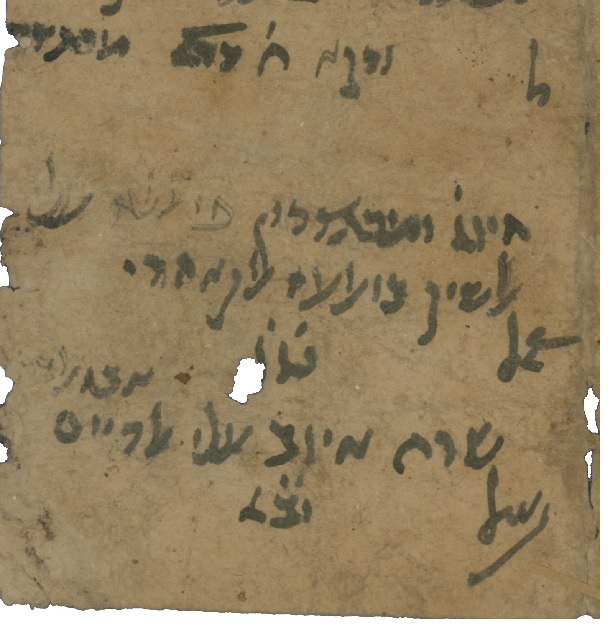
Detail from T-S 20.44 verso, lines 41 and 43 in the left column
The need to have a copy in order to follow the Hebrew morphology classes and the high price reflected in these lists must be responsible for the fact that some people had to be limited with what they could copy from their teachers during their magisterial dictations (imlāʾ) and thus we understand that two copies preserved in the Taylor-Schechter Collection contain on the one side the explanation of the vowels from Ḥayyūj’s treatise and on the other Saʿadiah Gaʾon’s explanation of the same subject (T- S NS 301.69 and T-S AS 140.13). Others would make their own private copies, like the one in question (T-S K7.56).
T-S NS 301.69 recto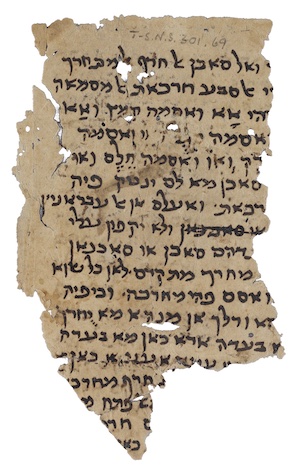
T-S NS 301.69 verso 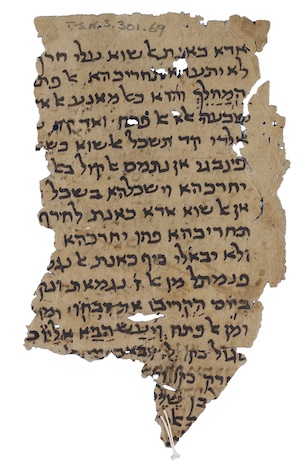
The fact is that from the time the book appeared in Córdoba, probably between the 960s and 970s, until the writing of Kitāb al-mustalḥaq by Ibn Janāḥ between the 1010s and 1020s, it was copied by both professionals and users for at least forty years, decades in which its transmission was affected by both glosses and errata (affecting both Arabic and Hebrew). Some felt the need to add more pronouns in Arabic to make the explanations clearer, while others confused reš with dalet and vice versa; in the case of Hebrew, there were those who decided to manipulate the length of the biblical quotations used as examples (šawāhid), alter the vowel sequences and even venture to add glosses with forms which, according to them, Ḥayyūj left out. These glosses were often incorporated into the text by the scribes. All these phenomena are already denounced by Ibn Janāḥ in the Saragossa of the Banū Tujīb (1018-1039) and are the result of the process of transmission of the text.6 On the other hand, Samuel ibn Nagrela states that he owned the autograph copy and that he used it to correct some of the misreadings that Ibn Janāḥ had found in the copies.7 The library of the Banū Nagrela was plundered along with all its possessions in Granada on 30 December 1066. Isaac ibn Bālyah later attempted to reassemble this library during his time in Seville in the service of King al-Muʿtamid (1069–89). The overthrow of the Taifa kings by the Almoravids (1089–90) caused Isaac to return to Granada, where he died in 1094.8 The copy of 1120, which claims to be mimmā nasakh linafsihi (‘a copy of the autograph’) and which is followed by other texts from Granada, may have been copied there.
The glosses that gradually invaded the original text soon crossed the Andalusi borders and thus Ibn Janāḥ tells us this curious anecdote in one of the last revisions he made of his Kitāb al-mustalḥaq about a relative who visited Egypt:9
ירה In this article we found that in one of the copies of this work he includes וַנִּירָ֛ם אָבַ֥ד חֶשְׁבּ֖וֹן (Numbers 21:30) and it has been said that what is more correct in this case is that it is from this root and later he says in another passage that it may be that וַנִּירָ֛ם (Numbers 21:30) is from those that have geminates. I say that it is impossible that it is from those that have geminates and I do not see the need to take this assertion apart with arguments since it is something that is clear to anyone who knows the rudiments of the weak letters and of those that have geminates. I make no case that the source of this assertion is Abū Zakariyyāʾ, rather, without a doubt, it comes from one of those who reflected on his book and added his own opinion in the margin of one of the copies, and the copyist copied it without knowing that it was a marginal annotation in this book and when he saw it, he thought that it was an assertion from the author. My cousin on my father’s side told me that in a copy of the Kitāb ḥurūf al-līn in Egypt, he saw corrupt notes that had been added to this as if they came from the author himself and that are nothing more than thoughts from some Andalusis who I know well; he showed me a handful that he had made note of for himself because he disapproved of them. This is what happened with וַנִּירָ֛ם (Numbers 21:30). This analogy is clearly confirmed by the fact that we do not find this assertion other than in this copy and also because Abū Zakariyyāʾ’s mastery of those that have geminates calls this opinion into question and makes a laughingstock of him to whom it is attributed. I warned about this in my book, fearing that more copies of this copy will be make, spreading the error among people and attributing it to the author.
The manuscript tradition shows that the root ירה received not one but two glosses. The first, when it appears, is usually integrated into the text, while the second can appear either integrated into the text or in the margins. The passage with both [glosses] would look like this:
יָרָ֣ה בַיָּ֑ם :ירה (Exod. 15:4), אֲשֶׁ֥ר יָרִ֖יתִי (Gen 31:51). יִירֶה [אִירֶה, נִירֶה, וְיִירֶה. וַנִּירֶה and וַיִּיר, וַנִּיר with apocope like וַיִּ֣יף בְּגָדְלּ֔וֹ (Ezek. 31:7), וַיִּ֣שְׁבְּ ׀ יִ֠שְׁמָעֵאל (Jer. 41:10)]. אֽוֹ־יָרֹ֣ה יִיָּרֶ֔ה (Exod 19:13), לִיר֥וֹת בְּמוֹ־אֹ֝֗פֶל (Ps. 11:2). הַיֹּרִ֔ים (2Chron. 35:23). וַיֹּ֤אמֶר אֱלִישָׁ֤ע יְרֵה֙ (2Kgs. 13:17). [It is possible that וַנִּירָ֛ם אָבַ֥ד חֶשְׁבּ֖וֹן (Numbers 21:30) is from this root and with this meaning. The first yod is the first radical of the verb. This is explained by the omission of the following word which shapes the meaning, such as חֵץ, עָפָר, חֵמָר or anything similar, so it means: “we shot them with our arrows, repulsed them and annihilated them” or “we threw them to the ground and cast them into the dust and mud and humiliated them”; as if it were saying וַנִּירָם חֵץ אָבַד חֶשְׁבּוֹן or וַנִּירָם לַחֹמֶר/לֶעָפָר, as in the case of הֹרַ֥נִי לַחֹ֑מֶר וָֽ֝אֶתְמַשֵּׁ֗ל כֶּֽעָפָ֥ר (Job 30: 19). It is possible that וַנִּירָ֛ם (Numbers 21:30) is of those with geminates, its root is רמם with a different meaning, as I have described its inflection and meaning in the Treatise on (verbs) with geminative (consonants)].
The heavy form is הֹרַ֥נִי לַחֹ֑מֶר (Job 30:19). וַֽאֲנִ֕י שְׁל֥שֶׁת הַֽחִצִּ֖ים צִדָּ֣ה אוֹרֶ֑ה (1Sam. 20:20). וַיֹּ֤אמֶר אֱלִישָׁ֤ע יְרֵה֙ וַיּ֔וֹר (2Kgs. 13:17), וַיֹּרֵ֗ם אֱלֹ֫הִ֥ים חֵ֥ץ (Ps. 64:8), וַיֹּרוּ֙ הַיֹּרִ֔ים (2Chron. 35:23). וַיִּמְצָאֻ֥הוּ הַמּוֹרִ֖ים (1Sam. 31:3).
Another meaning is אֲשֶׁ֣ר הוֹרָ֔הוּ יְהֽוֹיָדָ֖ע הַכֹּהֵֽן: (2Kgs. 12:3). וַיֹּרֵ֗נִי וַיֹּ֥אמֶר לִ֗י (Prov. 4:4). ה֭וֹרוּנִי וַֽאֲנִ֣י אַֽחֲרִ֑ישׁ (Job 6:24). וְֽלֹא־שָׁ֭מַעְתִּי בְּק֣וֹל מוֹרָ֑י (Prov. 5:13). לְהוֹרֹ֕ת בְּי֥וֹם הַטָּמֵ֖א (Lev. 14:57). It cannot be discarded that הֹר֧וֹ וְהֹג֛וֹ מִלֵּ֖ב דִּבְרֵי־שָֽׁקֶר: (Isa. 59:13) has this meaning.
A third meaning is יוֹרֶ֣ה וּמַלְק֑וֹשׁ (Deut. 11:14) and from this meaning אֶת־הַמּוֹרֶ֖ה לִצְדָקָ֑ה (Joel 2:23).
The first thing to bear in mind is that Ḥayyūj’s discourse is cryptic, with a synthetic register typical of lexicographers and imitating that of his master, Menaḥem ben Saruq (Tortosa-Córdoba 10th century), so that the implicit information is very numerous. The complete lexicographical article, without the glosses, could be read today as follows:10
ירה: [in paʿal form the perfect is] יָרָ֣ה בַיָּ֑ם (Exod. 15:4), אֲשֶׁ֥ר יָרִ֖יתִי (Gen 31:51). [The analogical form for the imperfect is] יִירֶה. [The absolute infinitive is] אֽוֹ־יָרֹ֣ה יִיָּרֶ֔ה (Exod 19:13) [showing that it functions in nifʿal with the same meaning], [the construct infinitive is] לִיר֥וֹת בְּמוֹ־אֹ֝֗פֶל (Ps. 11:2). [The active participle is] הַיֹּרִ֔ים (2Chron. 35:23). [The imperative is] וַיֹּ֤אמֶר אֱלִישָׁ֤ע יְרֵה֙ (2Kgs. 13:17). [Meaning ‘to shoot’].
The heavy form (hifʿil) is [in perfect] הֹרַ֥נִי לַחֹ֑מֶר (Job 30:19). [The imperfect is] וַֽאֲנִ֕י שְׁל֥שֶׁת הַֽחִצִּ֖ים הַֽחִצִּ֖ים צִדָּ֣ה אוֹרֶ֑ה (1Sam. 20:20). [The narrative imperfect is] וַיֹּ֤אמֶר אֱלִישָׁ֤ע יְרֵה֙ וַיּ֔וֹר (2Kgs. 13:17), [and with pronouns] וַיֹּרֵ֗ם אֱלֹ֫הִ֥ים חֵ֥ץ (Ps. 64:8); [the plural is] וַיֹּרוּ֙ הַיֹּרִ֔ים (2Chron. 35:23). [The participle is] וַיִּמְצָאֻ֥הוּ הַמּוֹרִ֖ים (1Sam. 31:3). [It also means ‘to shoot’]
Another meaning is (hifʿil) [in perfect is] אֲשֶׁ֣ר הוֹרָ֔הוּ יְהֽוֹיָדָ֖ע הַכֹּהֵֽן: (2Kgs. 12:3). [The narrative imperfect is] וַיֹּרֵ֗נִי וַיֹּ֥אמֶר לִ֗י (Prov. 4:4). [The imperative is] ה֭וֹרוּנִי וַֽאֲנִ֣י אַֽחֲרִ֑ישׁ (Job 6:24). [The noun is] וְֽלֹא־שָׁ֭מַעְתִּי שָׁ֭מַעְתִּי בְּק֣וֹל מוֹרָ֑י (Prov. 5:13). [The infinitive is] לְהוֹרֹ֕ת בְּי֥וֹם הַטָּמֵ֖א (Lev. 14:57). It cannot be discarded that [the infinitive] הֹר֧וֹ וְהֹג֛וֹ מִלֵּ֖ב דִּבְרֵי־שָֽׁקֶר: (Isa. 59:13) has this meaning. [Meaning ‘teach’]
A third meaning is יוֹרֶ֣ה וּמַלְק֑וֹשׁ (Deut. 11:14) and from this meaning אֶת־הַמּוֹרֶ֖ה לִצְדָקָ֑ה (Joel 2:23). [These are names for a kind of rain].
The first gloss [אִִירֶה, נִירֶה, וְיִירֶה. וַנִּירֶה and וַיִּיר, וַנִּיר with apocope like וַיִּ֣יף בְּגָדְלּ֔וֹ (Ezek. 31:7), וַיִּ֣שְׁבְּ ׀ יִ֠שְׁמָעֵאל (Jer. 41: 10)] seeks to complete the sphere of the imperfect which is not even attested in the Bible and further seeks to add the whole sequence for the narrative imperfect, giving rise to the inclusion of וַנִּירָ֛ם אָבַַ֥ד חֶשְׁבּ֖וֹן (Numbers 21: 30). From here the second gloss is introduced. Actually the author of the gloss is reworking the information he has found in Ḥayyūj’s introduction to weak third radical verbs, where he explains in a generic way that in:11
וַיֹּ֤אמֶר אֱלִישָׁ֤ע יְרֵה֙ וַיּ֔וֹר (2Kgs. 13:17), וַיּ֔וֹר is not taken from יָרָה, because in this root, I mean ירה, both the light (paʿal) and the heavy (hifʿil) forms are used: the light is יָרָ֣ה בַיָּ֑ם (Exod. 15:4) and the heavy is הוֹרָה, הֹרַ֥נִי לַחֹ֑מֶר (Job 30:19) and צִדָּ֣ה אוֹרֶ֑ה (1Sam. 20:20). Therefore, I say that וַיּ֔וֹר is taken from הוֹרָה and not from יָרָה, but its third radical has fallen off and the original is וַיּוֹרֶה; if it had been taken from יָרָה it would said וַיִּיר, as וַיִּ֣יף בְּגָדְלּ֔וֹ (Ezek. 31:7) which is taken from מַה־יָּפִית֙ וּמַה־נָּעַ֔מְתְּ (Song 7:7). This clarifies what I have said concerning the fact that וַיּ֔וֹר is not taken from יָרָָ֣ה בַיָּ֑ם (Exod. 15:4) but from הוֹרָה. If it had said וַיֹּאמֶר יְרֵה וַיִּיר it would be right, or if it said וַיֹּאמֶר הוֹרֵה וַיּוֹר it would also be correct.
The active participle drawn from יָרָָ֣ה בַיָּ֑ם (Exod. 15:4) is יוֹרֶה as עָשָׂה and עוֹשֶׂה; the plural is יוֹרִים with the deletion of the third radical of the verb, as עוֹשִׂים.
The active participle extracted from הוֹרָה is מוֹרֶה as הִרְבָּה and מַרְבֶּה, since any active participle of a heavy verb form will only be enunciated with mem; the plural is מוֹרִים as מַרְבִּים; in מוֹרִים waw is the first radical of the verb, while the third radical has fallen.
It has become clear from what I have described and explained that הַיֹּרִ֔ים (2Chron. 35:23) is from יָרָָ֣ה בַיָּ֑ם (Exod. 15:4), while וַיִּמְצָאֻ֥הוּ הַמּוֹרִ֖ים (1Sam. 31:3) is from הֹרַ֥נִי לַחֹ֑מֶר (Job 30:19) and from וַיֹּרֵ֗ם אֱלֹ֫הִ֥ים חֵ֥ץ (Ps. 64:8). Now whereas waw in הַיּוֹרִים does not belong to the root, in הַמּוֹרִים it is the first radical of the verb.
Therefore, the first gloss follows the analogy of Ḥayyūj if the same binyan had been used for both the command and its execution in וַיֹּ֤אמֶר אֱלִישָׁ֤ע יְרֵה֙ וַיּ֔וֹר (2Kgs. 13:17): יְרֵה וַיִּיר or הוֹרֵה וַיּוֹר. That supposed and analogical narrative imperfect paʿal וַיִּיר shares a pattern with וַיִּ֣יף בְּגָדְלּ֔וֹ (Ezek. 31:7), a reading which to add more to the confusion we can only find in the Ben Naftali tradition of vocalising the Bible (e.g., it is found in the Cairo Codex of Prophets, as well as being listed in the Kitāb al-Khilaf), which is typical of Ḥayyūj, while the other prestigious codices that are preserved (Leningrad and Aleppo codices) read, with Ben Asher, וַיְּיִ֣ף. This correct reading of Ḥayyūj is corroborated by the author of the gloss when he adds as a second example וַיִּ֣שְׁבְּ ׀ יִ֠שְׁמָעֵאל (Jer. 41:10), perhaps aware of the existence of both variants.
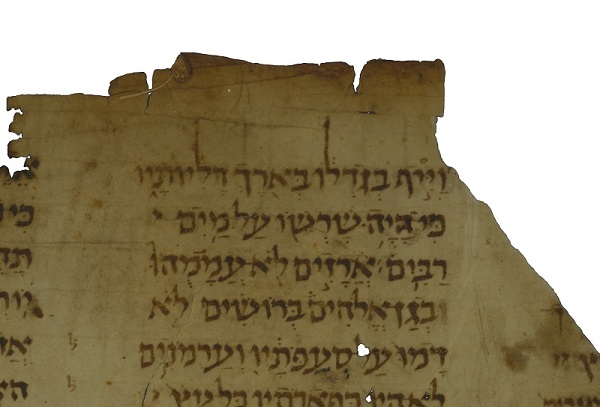
Detail from T-S NS 62.2 verso: this Ben Naftali reading can be found in many other copies from the Genizah
The second gloss, much coarser and more blatant, clearly departs from Ḥayyūj’s own synthetic discourse and borders on vulgarity, offering translations of the passage, something that never happens with Ḥayyūj, except in a very few exceptional cases and always with frequently occurring roots that everyone knows. It can be clearly detected how וַיֹּרֵ֗ם אֱלֹ֫הִ֥ים חֵ֥ץ (Ps. 64:8) and הֹרַַ֥נִי לַחֹ֑מֶר (Job 30: 19) serve as inspirational muses to our gloss’s author, possibly a Hebrew poet, who, if he was right, misses the boat by inviting the possibility of attempting to catalogue this voice as a geminate root, showing that he is not worthy of having his opinions recorded in writing and taken into consideration by the great masters, the only ones who can give it as valid.
This helps us to understand Ibn Janāḥ’s derision and his attempt to have these amateurish passages such as this one removed from the standard version circulating among the public. However, his words fell on deaf ears, as shown in fragment T-S K7.56.
T-S K7.56 recto 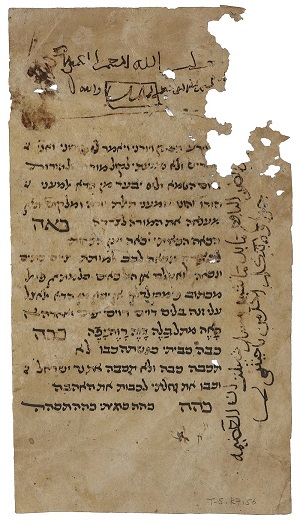
T-S K7.56 verso 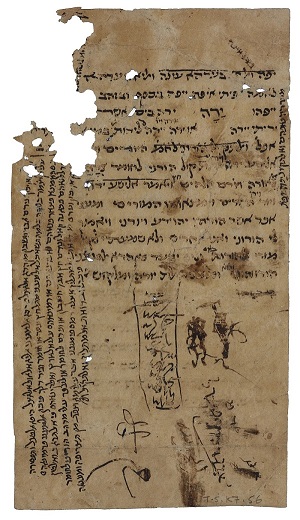
This long introduction serves to understand the nature of our fragment. From its design with a large blank space on the recto side, it seems to fit into the typology of copies for personal use. It cannot be ruled out that it was originally intended as a copy for public distribution, but the difficulty of editing the text meant that this possibility was lost. The handwriting is familiar, and it is easy to recognise that the text expressed in Hebrew script (both in the corpus and even in the gloss) are in the hand of Solomon ben Samuel ben Saʿadia Halevi (first half of the 13th century), a scribe known for his very neat and exquisite copies of Maimonides’ writings.
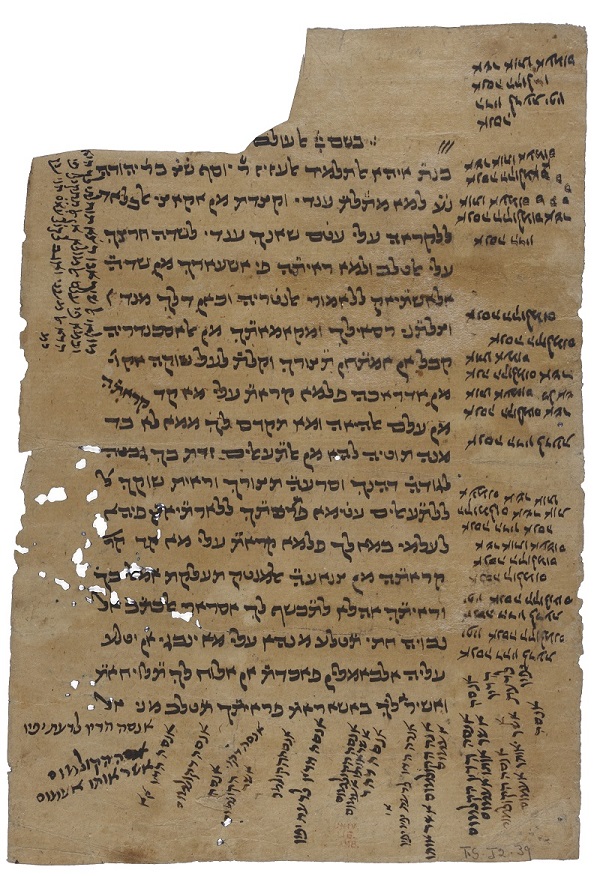
T-S J2.39 verso
The white gap caused by the editing process has been used as a draft for practising Arabic and Hebrew scripts, and thus we find an Islamic basmala, all kinds of jottings, and even a symbol found in other texts with a magical or esoteric nature. If we look at the root we are dealing with, ירה, the result is as follows:
יָרָה ירה בים אשר
יריתי יירה או ירה אירה ויר יירה֯ לירות v במו
אפל ואלתקיל הורני לחמ היורים ויאמר
אלישע ירה ויור֯ ואלתֿקיל הורני לחומר צִדָה
אורה ויורם אלהים חץ ויאמר אלישע ירה
ויור וירו היורים וימצאוהו המורים ומעני
אכר אשר הורהו יהוידע ויורני ויאמר
לי הורוני ואני אחריש ולא שמעתי לקול
מורי ולהורות ביום וליס יבעד מן הדא אלמעני
הורו והוגו וְתׄואׄ ומעני תאלת יורה ומלקוש
ו[ימכן] אן יכון נירם אבד חשבון מן הדא אלאצל פיכן אלמעני אליא אלאול אלאצל הי פא אלפעל ותפסירה / עלי אן יُצׄמר בעדה כלמה תשאכל אלמעני מתל חץ עפר או חומר וגיר דלך פיכון אלמעני פרמינאהם / בסהאמנא פצארפנאהם ואבדנאהם או רמינאהם עלי אלארץׄ ואלקינאהם פי אלתראב ואלטין / [ו]דללנאהם פכאנה קאל ונירם חץ אבד חשבון או ונירם לחומר או לעפר עלי מדהב הוריני לחומר / [וימ]כן אן יכון ונירם מן דואת אלמתלין אצלה רמם פי מעני אכר עלי מא וצפתֿ מן תצריפה ומענאה / פי כתאב דואת אלמתלין ואלתקיל
יָרָ֣ה בַיָּ֑ם :ירה (Exod. 15:4), אֲשֶׁ֥ר יָרִ֖יתִי (Gen 31:51). אֽוֹ־יָרֹ֣ה יִיָּרֶ֔ה .[אִירֶה. וַיִּיר] יִירֶה (Exod 19:13), לִיר֥וֹת בְּמוֹ־אֹ֝֗פֶל (Ps. 11:2). הַיֹּרִ֔ים (2Chron. 35:23). וַיֹּ֤אמֶר אֱלִישָׁ֤ע יְרֵה֙ וַיּ֔וֹר (2Kgs. 13:17).
[It is possible that וַנִּירָ֛ם אָבַ֥ד חֶשְׁבּ֖וֹן (Numbers 21:30) is from this root and with this meaning. The first yod is the first radical of the verb. This is explained by the omission of the following word which shapes the meaning, such as חֵץ, עָפָר, חֵמָר or anything similar, so it means: “we shot them with our arrows, repulsed them and annihilated them” or “we threw them to the ground and cast them into the dust and mud and humiliated them”; as if it were saying וַנִּירָם חֵץ אָבַד חֶשְׁבּוֹן or וַנִּירָם לַחֹמֶר/לֶעָפָר, as in the case of הֹרַ֥נִי לַחֹ֑מֶר וָֽ֝אֶתְמַשֵּׁ֗ל כֶּֽעָפָ֥ר (Job 30: 19). It is possible that וַנִּירָ֛ם (Numbers 21:30) is of those with geminates, its root is רמם with a different meaning, as I have described its inflection and meaning in the Treatise on (verbs) with geminative (consonants)].
The heavy form is הֹרַ֥נִי לַחֹ֑מֶר (Job 30:19). צִדָּ֣ה אוֹרֶ֑ה (1Sam. 20:20). וַיֹּרֵ֗ם אֱלֹ֫הִ֥ים חֵ֥ץ (Ps. 64:8). וַיֹּ֤אמֶר אֱלִישָׁ֤ע יְרֵה֙ וַיּ֔וֹר (2Kgs. 13:17). וַיֹּרוּ֙ הַיֹּרִ֔ים (2Chron. 35:23). וַיִּמְצָאֻ֥הוּ הַמּוֹרִ֖ים (1Sam. 31:3).
Another meaning is אֲשֶׁ֣ר הוֹרָ֔הוּ יְהֽוֹיָדָ֖ע (2Kgs. 12:3). וַיֹּרֵ֗נִי וַיֹּ֥אמֶר לִ֗י (Prov. 4:4). ה֭וֹרוּנִי וַֽאֲנִ֣י אַֽחֲרִ֑ישׁ (Job 6:24). וְֽלֹא־שָׁ֭מַעְתִּי בְּק֣וֹל מוֹרָ֑י (Prov. 5:13). לְהוֹרֹ֕ת בְּי֥וֹם (Lev. 14:57). It cannot be discarded that הֹר֧וֹ וְהֹג֛וֹ (Isa. 59:13) has this meaning. A third meaning is יוֹרֶ֣ה וּמַלְק֑וֹשׁ (Deut. 11:14).
The first phenomenon to focus on is the length of the quotations, which I believe depends on the knowledge of each user, and it is up to them to decide what length they need to locate or recognise the passage and all its context. The second is that Solomon ben Samuel ben Saʿadia Halevi has sought to preserve and reproduce the history of the text as we have seen it before. The result has not been good. In fact, he has had to discard the remains of the folio and continue copying the treatise on the verso, leaving half of the recto side blank.
Solomon proves to be a very professional editor. The first gloss has no place in his personal copy, only tentatively picking up analogical forms that can be attributed to Ḥayyūj. However, that the form וַיִּיר is identical with וַיִּ֣יף בְּגָדְלּ֔וֹ (Ezek. 31:7) is unacceptable to him, because he surely knew no other reading than Ben Asher’s, the one we find in Leningrad and Aleppo: וַיְּיִ֣ף, hence he dismisses it. This would further lead him to be suspicious of אֶת־הַמּוֹרֶ֖ה לִצְדָקָ֑ה (Joel 2:23) in the third meaning and discard it, because after all, what is Ḥayyūj doing recording so many nominal forms in a treatise on verbal morphology and in an article where he has not even remembered that the nominal schema of the second meaning is nothing more than תּוֹרָה, as he has explained in the introduction to this type of verbs.
The second gloss does have a place but only marginally. Solomon clearly has a good knowledge of the history of the text and is following Ibn Janāḥ’s indications, so he includes it marginally, since Ibn Janāḥ himself has acknowledged that the gloss was introduced by Hebrew Andalusi philologists, who enjoyed the same international prestige as the Arabic Andalusi philologists. Solomon is not taking sides, he is simply editing his own version of the text according to the history of its transmission.
What I cannot explain is whether the big blank space is the result of the confusion created by all these glosses or whether he consciously left it blank with the intention of editing the article again in the future. Something that never happened.
In any case, T-S K 7.56 is not an isolated case. Of the eleven copies that preserve this passage, only four omit these glosses. There are different options:
Those that do not include the glosses and follow what is intended to be the original reading: Bodleian Library Pococke 99 and 134; and RNL Evr-Arab I 4555 and I 4565.
Those that do not include the glosses but accept that וַנִּירָ֛ם אָבַ֥ד חֶשְׁבּ֖וֹן (Numbers 21:30) follows וַיֹּ֤אמֶר אֱלִישָׁ֤ע יְרֵה֙ וַיּ֔וֹר (2Kgs. 13:17): RNL Evr-Arab I 4556.
Those that only collect the first gloss marginally: RNL Evr-Arab I 2602.
Those that only include the first gloss and integrate it into the text: RNL Evr-Arab I 4574.
Those that include the second gloss marginally: T-S K7.56 and RNL Evr-Arab II 643; the latter copy does not preserve the beginning of the article and it is impossible to know what happened to the first gloss.
Those that integrate both glosses in the corpus of the treatise: RNL Evr-Arab I 2371 and II 643.
As I said at the beginning, few Judeo-Arabic texts have such a rich manuscript tradition as this book, one of the most widely read and studied throughout the Middle Ages.
* This study was financed by the ERDF/Ministry of Science, Innovation and Universities – State Research Agency/PGC2018-094407-B-I00, Legado judeo-árabe de al-Andalus: patrimonio lingüístico.
Footnotes
1 Pococke 99 dated in 1332–1333 (Neubauer 1452) and Pococke 134 dated in 1316 and copied in Cairo (Neubauer 1453).
2 Morris Jastrow, The weak and geminative verbs in Hebrew by Abû Zakariyyâ Yaḥyâ ibn Dâwud of Fez, Known as Ḥayyūḡ. Leiden: Brill 1897; and Daniel Sivan and Ali Watad, Three Treatises on Hebrew Grammar by R. Judah Hayyuj: A New Critical edition of the Arabic Text with a Modern Hebrew Translation. Beer Sheva: Universitat Ben-Guriyon baNegev 2012.
3 The copies kept in the British Library (BL Or 2594) and in the State Library of Berlin (Or. Oct. 242) are in fact fragments of bigger copies kept in the National Library of Russia.
4 José Martínez Delgado, Kitāb al-mustalḥaq by Ibn Ǧanāḥ of Cordoba: A Critical Edition, with an English Translation, Based on All the Known Judaeo-Arabic Manuscripts. Cambridge Genizah Studies Series, Volume 11. Leiden-Boston: Brill 2020.
5 See the lists number 4, 5, 6, 17, 30, 40, 45, 47, 67 (twice), 97 and 106 in Nehemya Allony, The Jewish library in the Middle Ages: book lists from the Cairo Genizah, edited by Miriam Frenkel, Haggai Ben-Shammai, with the participation of Moshe Sokolow. Jerusalem: Ben Zvi Institute 2006.
6 See the introductory study in Martínez Delgado, Kitāb al-mustalḥaq and the edition in Ahmad Alahmad Alkhalaf and José Martínez Delgado, Risālat altaqrīb wa-l-tashīl de Abū l-Walīd Marwān ibn Ǧanāḥ de Córdoba. Edición diplomática y traducción. Colección Benito Arias Montano. Monografías. Arabica, 4. Madrid: Sindéresis 2018.
7 See the introductory study in Martínez Delgado, Kitāb al-mustalḥaq p. 15.
8 All the data on Isaac ibn Bālyah is given by Abraham ibn Daud (1110-1180), in his Sefer ha-Qabbalah (see Gerson D. Cohen, A Critical Edition with a Translation and Notes of the Book of Tradition (Sefer ha-qabbalah) London: Routledge & K. Paul, 1969.
9 See Martínez Delgado, Kitāb al-mustalḥaq p. 168 for the original text, and pp 324-325 for the translation.
10 I am following here the edition by Jastrow, The weak and geminative verbs, p. 178.
11 I am following here the edition by Jastrow, The weak and geminative verbs, pp. 141-142.
If you enjoyed this Fragment of the Month, you can find others here.
Contact us: genizah@lib.cam.ac.uk
The manuscripts in this article are part of the Cairo Genizah Collection in Cambridge University Library. To see more items from this collection visit: https://cudl.lib.cam.ac.uk/
